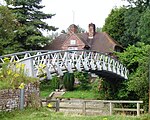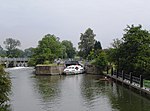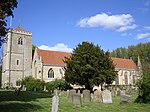Brightwell Barrow
Barrows in the United KingdomHistory of BerkshireHistory of OxfordshireOxfordshire geography stubs

Brightwell Barrow is a Bronze Age round barrow in the civil parish of Brightwell-cum-Sotwell in the English county of Oxfordshire (formerly Berkshire). It lies just under a kilometre from Wittenham Clumps. Its position is marked by a small clump of trees on its peak. Brightwell Barrow is mentioned in the Domesday Book under the entry for Brightwell-cum-Sotwell.
Excerpt from the Wikipedia article Brightwell Barrow (License: CC BY-SA 3.0, Authors, Images).Brightwell Barrow
Sires Hill, South Oxfordshire Brightwell-cum-Sotwell
Geographical coordinates (GPS) Address Nearby Places Show on map
Geographical coordinates (GPS)
| Latitude | Longitude |
|---|---|
| N 51.623 ° | E -1.169 ° |
Address
Sires Hill
OX10 0QX South Oxfordshire, Brightwell-cum-Sotwell
England, United Kingdom
Open on Google Maps










